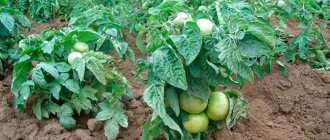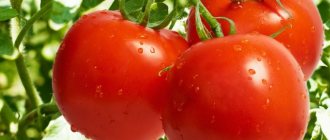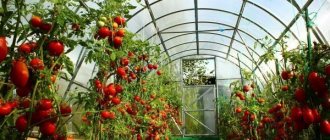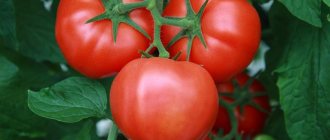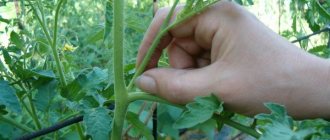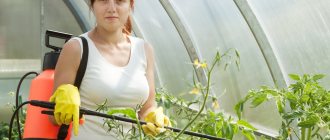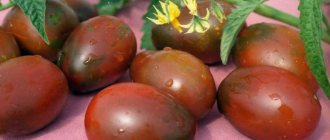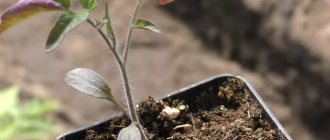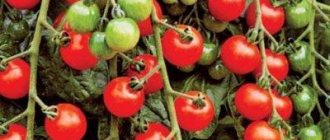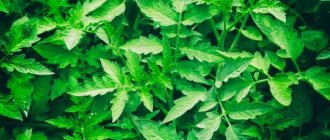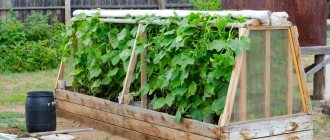Author's rating
Author of the article
Yakov Pavlovich
Professor, Head of the Department of Vegetable Growing
Articles written
153
When purchasing bags of vegetable seeds, in addition to familiar information, you can also see the following designation: determinate variety. What does this mean for tomatoes and other vegetables? Determination characterizes the height of the plant and means that its growth is limited. This determines the methods of caring for it, the planting location, and the yield. There are indeterminate tomatoes, the growth of which must be limited.
What does determinate tomato mean?
Determinate means that the plant will be short, branched, and early ripening.
The variety is divided into the following subspecies:
- semi-determinate;
- determinant;
- superdeterminant;
- super-superdeterminant.
Let's take a closer look at each variety.
Semi-determinant
The height of a tomato bush reaches 1-1.2 m. They are grown in two stems in greenhouses and open ground.
Determinant
This species differs from the previous one in that its height is 70 cm. With the appearance of the first fruit cluster, the growth of the main stem stops, new fruits are formed on the side shoots. Determinate varieties are suitable for growing in open beds.
Superdeterminant
These are early ripening low-growing plants with strong branching. Their fruits are of medium size; pinching is not required.
Supersuperdeterminant
These include super early-ripening tomatoes of dwarf growth. Their bushes are highly branched, pinching and pinching are not required, and they bear fruit abundantly with small tomatoes.
Semi-determinant
Stopping the growth of the bush does not mean that the tomatoes will be stunted. The semi-determinate variety stops growing not only at a level of 1 m, but also at a height of 2 meters. Inflorescences are formed after the 9th shoot. On average, 10 bunches of tomatoes ripen on a bush. Medium-sized seedlings can be planted directly in the garden, or grown indoors.
The transitional option combines the positive qualities of both determinate and indeterminate species:
- the first fruits ripen earlier than on full-size bushes;
- The harvest period is extended over several months.
Like tall-growing tomatoes, semi-determinate tomatoes require formation into 2 stems, pinching, and also tying to a trellis or piece supports.
What is the difference between determinate and indeterminate tomatoes?
These tomato varieties are popular among Russian gardeners; each of them has admirers. Before choosing, you should know the differences.
See also Tomato variety Big Mom: description and yield of tomatoes
Differences between indeterminate and determinate varieties and hybrids
| № | Characteristics | Determinant | Indeterminate |
| 1 | Bush growth | Limited, no more than 1.2 meters | Unlimited, up to 4 meters |
| 2 | Plant Formation | Does not require pinching the top or garter. | Pinching the top of the main stem at a height of 2 meters, gartering. |
| 3 | Stepsoning | You don't have to stepchild. | Remove the shoots and leave one stem. |
| 4 | Fruit cluster size | Small in size, small in super-super-determinants. | Large. |
| 5 | Ripening time | Early and super early | Large ones. |
| 6 | Fruit size | Small or medium. | Large ones. |
| 7 | Growing regions | All regions of Russia. | Southern, central regions in greenhouses. |
Among determinate tomatoes, standard ones are popular. They have a thick stem and do not require staking or pinching. They are grown on an industrial scale in open ground. They are early ripening, the first ripe tomatoes appear at the end of June.
Advantages and disadvantages of determinate tomatoes
The main advantage of determinate varieties is the limited growth of the bushes, which makes it easier to grow tomatoes in unprotected soil or low greenhouses. Advantages of the short type:
- In temperate climates, as well as in regions with short summers, a determinate plant allows you to get an early harvest.
- The fruits are characterized by uniform size and good taste.
- Vegetables ripen at the same time.
- The bushes do not need pinching or shaping; they are easier to care for.
The disadvantages of the determinant type include:
- the need for enhanced mineral supplements;
- overall yield indicators are lower than those of tall varieties;
- reduced immunity.
Which type of tomatoes is better?
There is no consensus on which tomato variety is better. Everyone is good in their own way. We can only highlight their advantages and disadvantages.
Determinant. Positive characteristics include early ripening and abundance of fruits. Disadvantage: lower yield, need for frequent feeding, susceptibility to diseases.
Indeterminate. Plus - obtaining a high yield per unit area, resistance to diseases, long-term fruiting, you can harvest tomatoes until late autumn. The downside is that it's difficult to care for. Constant shaping of the bush, removal of shoots and leaves, repeated staking of the plant.
Expert opinion
Stanislav Pavlovich
Gardener with 17 years of experience and our expert
Ask a Question
Important. When choosing a tomato variety, you need to evaluate your capabilities for caring for plants, the place where they are grown - beds or a greenhouse, the desire to receive fruits earlier or harvest before the fall.
Review of other differences between tomatoes from different groups
Plant height and recommended growing regions are not the only differences between indeterminate and determinate tomato varieties, as there are other important characteristics. For ease of understanding, the parameters are placed in a table.
| Parameter | Determinant culture | Indeterminate culture |
| Plant Height Limit | The tomato stem grows to the small height stated by the manufacturer. Growth stops on its own without the need to pinch the top. | Under favorable conditions, the plant is capable of growing a stem of unlimited height. Pinching the top is mandatory, otherwise the bed will overgrow into an impenetrable jungle. |
| Garter to support | A low-growing plant usually supports itself on its stem. Standard crops are considered particularly resistant. | Without support, a tall plant cannot exist. To grow tomatoes you need to build wire or rope trellises. |
| Brush characteristics | The plant produces clusters consisting of a small number of fruits. With each subsequent tier, the tomatoes become smaller along the height of the stem. | The plant forms large clusters. On each tier the tomatoes are almost all the same size. There may be slight variations in weight. |
| Stepchildren | After the bush stops growing, it rapidly grows stepsons that need to be removed. | To form a bush, pinching is necessary. However, the plant forms stepsons in small quantities. |
| Fruit ripening | A distinctive feature of tomatoes is the uniform ripening of the crop. It's usually early. | The fruits ripen unevenly. The ovary is formed before the onset of frost. |
| Seeds | The grain size is medium or small, the appearance is normal. | The seeds are large, significantly distinguished by their increased diameter, and differ in appearance from tomato grains of low-growing varieties. |
| Seedling | After germination, the sprouts appear with short knees. The plants are low on thin stalks. | When the sprouts appear, knees immediately stand out, the length of which reaches 3-5 cm. The seedlings rapidly grow in height and form powerful stems. |
After comparing the characteristics from the table, you no longer have to wonder what determinate and indeterminate tomatoes mean. It remains to find out the pros and cons of growing tall crops.
Advantages
- Vertical cultivation of tall crops saves space. A gardener gets a large amount of harvest from a small garden bed. The average is 16 kg/1 m2, but it all depends on the variety.
- Bushes are more resistant to diseases. The need to remove the lower layers of foliage improves the ventilation of plantings. The likelihood of late blight is reduced.
- The long fruiting period allows you to get fresh fruits throughout the warm season.
- Simple care is due to the need to form a bush, most often with one stem. The lashes are fixed to the support. The harvest is harvested at full height, rather than crawling around the garden bed on your knees.
Having figured out what an indeterminate plant means and what its advantages are, you shouldn’t rush to get one right away. Such tomatoes have their own disadvantages that need to be taken into account. The downside is the need to build a support. Each stem must be tied to a trellis. Manual labor is hard and takes a lot of time.
When a vegetable grower has a good idea of what an indeterminate tomato variety means with all its pros and cons, it is easier for him to choose the appropriate crop for growing. If there is a greenhouse or weather conditions permit, tall tomatoes will yield more than their low-growing counterparts.
Features of cultivation
Caring for determinate and indeterminate tomatoes has some differences.
Planting and caring for low-growing tomatoes
The seeds are sown at the end of February in fertile soil. The containers are covered with film and placed in a warm place until shoots appear. Next, the film is removed and sufficient lighting is provided to the plant. When the seedlings have 2-3 true leaves, they are picked into separate cups.
See also: The best tomato varieties for Siberia in a greenhouse
Determinate tomatoes can be planted in a greenhouse or open ground. Carry out the usual care - water, loosen, feed. Dwarf varieties are not planted or tied up. Taller ones require garters; there is no need to remove the stepsons.
Growing indeterminate varieties of tomatoes
Sowing seeds and caring for seedlings is no different from determinate species; differences appear at the stage of formation of tomato bushes. It is important to carry out pinching in time and remove all side shoots. The bush is formed into one trunk. You can leave a shoot under the first fruit cluster and form a bush into two stems. After the plant reaches a height of 2 m, the top of the stem is pinched to limit its growth.
Indeterminate tomato variety: what is it?
Unlike determinate ones, this type of bush does not stop growing the central stem, reaching a height of 2 to 6 m. Tall indeterminate tomatoes can be grown in greenhouses all year round, since the growing season of plants is much longer than that of short ones. To support the stems, different types of trellises or supports are used, to which climbing tomatoes will have to be tied. A large area is not needed for the growing season; 0.3 m² per each is enough.
The formation of bushes is of particular importance for indeterminate varieties. The tops of plants can be pinched to stop growth, and excess shoots can be trimmed as the foliage thickens. An abundance of greenery will lead to a decrease in yield, and the fruits will not be able to gain sufficient weight, remaining small.
The best varieties
It is important to choose high-yielding and disease-resistant tomato varieties. Let's consider the proposals of breeders.
Determinate tomatoes
Plants of Siberian selection are good for open ground and cool climates. Among the popular ones:
- “Snow Fairy Tale”, early ripening, prolific, with small fruits (35 g), does not require support.
- "Hospitable." Medium ripening period, tomatoes weigh up to 500 g.
- "Destructive force". Fruit weight 150 g.
Suitable for greenhouses:
- Apricot. It has a yellow fleshy fruit weighing 110 g. It is grown in greenhouses and open ground.
- Agatha. Low-growing up to 45 cm. Early, productive, for growing in greenhouses and open beds.
- "Lyubasha-F2". Early ripening, low growing. Red fleshy, weight 120-200 g.
Photo gallery
Watermelon
Aston F1
Kronos F1
Mandarin duck
Poznan
Shannon F1
Sweet bunch
Sprinter F1
meal
golden brush
Stepsoning
The question of how to properly plant tomatoes of these types is quite acute. Even experienced gardeners cannot give an exact answer. It seems that pinching determinants is simply cutting off unnecessary shoots.
But it turns out that you can remove the stepsons only when they grow by 3-4 cm. If you are late, then you should not try to remove a large process. When it is removed, the result will be a deep wound that will slow down the development of the plant.
An indeterminate plant, due to its high growth, also has many unnecessary stepsons. They stop growing when the tomatoes on the bushes ripen. Therefore, it is necessary to remove the stepsons before the fruits ripen, so that the extra shoots do not take away their nutrition.
Stepchildren should be removed once a week. The leaves also need to be cut off, leaving a few leaves above the fruits that have already set.
In a greenhouse, pinching should be done more often than in an open garden bed. It is recommended to remove stepsons and excess inflorescences every 4-5 days.
How to stepchild?
Tomatoes should be harvested in the morning and preferably in sunny weather. This will help the wounds heal quickly, and rot will not develop at the cut site. Stepchildren must be removed regularly until they reach 5 cm in length.
Important! When breaking out the stepson, you need to leave a stump 2 cm long. This will slow down the growth of new stepsons in this place.
Planting and care
If you want to get a quick harvest, then you need to leave a distance of at least 35-40 cm between determinate bushes. They ripen early and almost simultaneously, so they need a large distance between the bushes.
Many gardeners plant seedlings not in holes, but in trenches. It is believed that this makes maintenance and watering easier. As a result, you will not have to water under each bush, but directly into the trench. It is also more convenient to apply fertilizers in a trench. Yes, and loosening is much more convenient.
The soil in the garden bed should be fertile and light. After planting, the plants should be watered with warm, settled water. After watering, as a rule, potassium fertilizers must be applied once every 14 days.
Advantages
- Bushes of this type are tall and are grown in one trunk, tied vertically to a support. This method increases the amount of harvest and guarantees approximately 16 kg. From one square meter;
- Tomato bushes are practically not exposed to diseases that are inherent in tomatoes; during cultivation, the lower leaf plates are removed before ripening tomatoes, and this increases the access of fresh air, which helps fight fungal diseases;
- Extended fruiting period - usually lasts until the first severe cold snap. In the southern regions of Russia, the end of fruiting can be considered the end of October;
- Care is quite simple , since this type of bush is cultivated in one stem, all stepsons are removed.
- Harvesting is simple for a summer resident ; there is no need to bend over or crawl on your knees.
